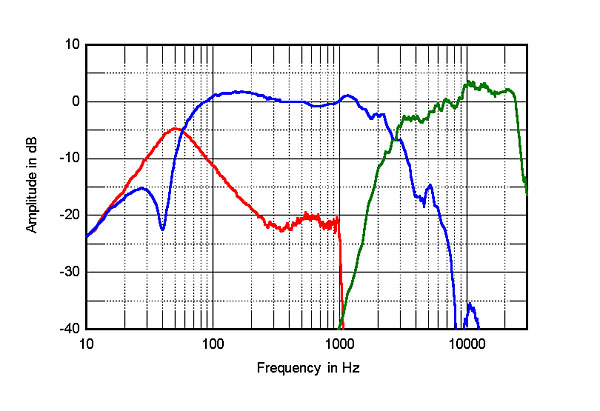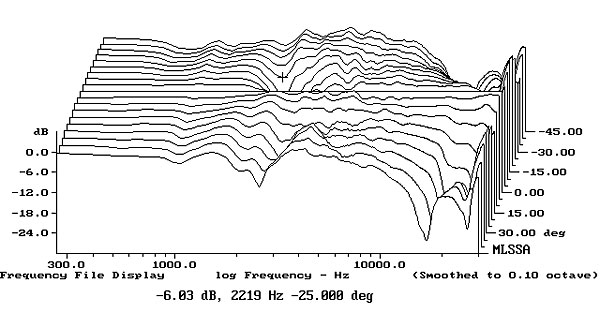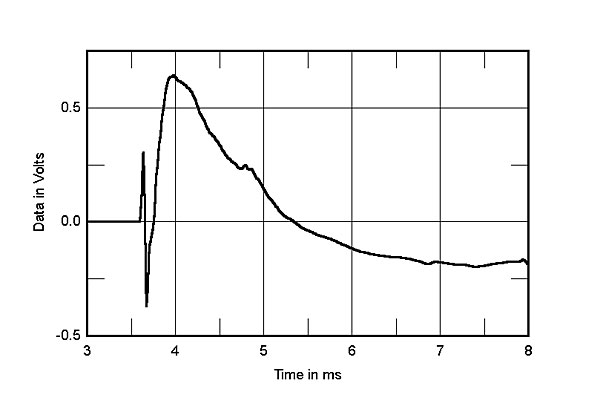| Columns Retired Columns & Blogs |
Oh yeah, now I remember, He's the guy that got run out of town by "Old goats". Heh heh.
The Studio 100 was quite sensitive at an estimated 86dB/W/m (B-weighted), although I would have thought this would be marginal for use with a 2W amplifier. Its impedance, however, would be acceptable to PETA (People for the Ethical Treatment of Amplifiers). Fig.1 shows that, apart from at the port tuning frequency of 44Hz and in the upper bass, where it drops to a minimum value of 6.75 ohms at 200Hz, the impedance remains above a benign 8 ohms. A very slight wrinkle at 280Hz, probably not visible at the scale graphs are printed in Stereophile, indicates the possible presence of a cabinet resonant mode. The higher-frequency bend at 600Hz, however, is probably due to some kind of equalization network in the crossover.

Looking at the individual responses of the drivers and the port (fig.2), the latter's output is centered on 50Hz, staggered a little from the minimum-motion point of the woofer at 40Hz. The port's HF rollout ceases in the midrange, though no peaks are evident, then drops dramatically at 1kHz, this notch associated with some ripples in the port's impulse response (not shown). The woofer's output is pretty smooth and flat in its passband. Though its low-pass rolloff is broken by some residual cone-breakup modes, these are well down in level. The tweeter's high-pass slope is a steep 24dB/octave, implying a fourth-order high-pass filter. The tweeter also has a shelved-up top octave.

Fig.3 shows how all this adds up. The sum of the woofer and port outputs peaks broadly between 50Hz and 200Hz, implying excellent bass weight and extension for a speaker this size. The –6dB point is very low, at 33Hz lying well below the lowest note of the orchestral double-bass and the four-string bass guitar. The price to be paid for this measured performance, however, is a rather undercontrolled quality, as CG found in his auditioning. Higher up in frequency, the midrange is impressively flat, as might be expected from the consistently positive comments CG made about this region. The high treble is shelved up, however, which presumably ties in with Corey's finding the ProAc to be too hot in this region. Although CG also noted a brightness to the speaker's sound, this can't be laid at the feet of this tweeter balance, which is too high in frequency. Subjective brightness is generally associated with balance or resonant problems lower down in frequency, in the mid-treble.

The Studio 100's horizontal dispersion (fig.4) is typical for a two-way with a relatively large woofer. A discontinuity develops in the crossover region at extreme off-axis angles, due to the restricted dispersion of the woofer at the top of its passband not matching the wide dispersion of the tweeter at the bottom of its passband. Nevertheless, other than in the top octaves, the ProAc's balance doesn't change significantly until the listener is more than 30° off-axis, which is good. Note that, on the other side of the baffle from the tweeter (the rear of the graph), there is a lot more mid-treble energy evident off-axis. It's possible that this, perhaps in combination with the step in the horizontal dispersion, is what led CG to comment on the Studio 100 being "bright," particularly as in all other respects the Studio 100 offers almost textbook measured performance throughout the upper midrange and low treble.

Elsewhere in this issue, Martin Colloms discusses the interaction between an amplifier's source impedance and the manner in which a speaker's impedance changes with frequency. Close inspection of the fig.1 magnitude trace reveals a possible reason why Corey much preferred the Studio 100's balance when driven by a tube amplifier with a high output impedance. Assuming a 3 ohm output impedance for the amplifier and taking the 1kHz impedance as a reference, the ProAc's top audio octave will be knocked down by 0.75dB, which will sweeten the highs a little, while the lower midrange will be attenuated by 2dB. More importantly, the low treble will be effectively boosted by 3.4dB, giving a better subjective balance between the low and mid-treble.
Vertically (fig.5), the balance doesn't change appreciably between the tweeter axis and the base of the woofer frame. Above and below, the treble rolls off, and a big suckout develops in the crossover region. One puzzling aspect of these dispersion plots is that when a tweeter has limited top-octave dispersion, as is the case here, this will tend to ameliorate the effect of an on-axis excess of energy. Nevertheless, CG was bothered by the ProAc's top-octave balance, reinforcing the fact that interpreting speaker measurements will never be a straightforward task.

In the time domain, the Studio 100's step response (fig.6) indicates that the drivers are connected with the same positive acoustic polarity, but with the tweeter output leading that of the woofer by about 0.4ms—as might be expected from the conventional flat baffle. The associated cumulative spectral-decay, or waterfall, plot (fig.7) is simply superb, there being very low levels of residual hash. This is a sign of a clean, grain-free midrange.


The wrinkle just under 300Hz in the impedance plot ties in with a reasonably strong cabinet resonance at 285Hz, this detectable on all surfaces. Fig.8, for example, shows a waterfall plot calculated from the impulse response of a simple plastic-tape accelerometer fastened to the center of the side panel.—John Atkinson


Oh yeah, now I remember, He's the guy that got run out of town by "Old goats". Heh heh.